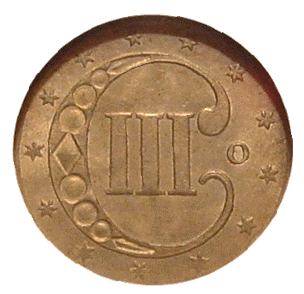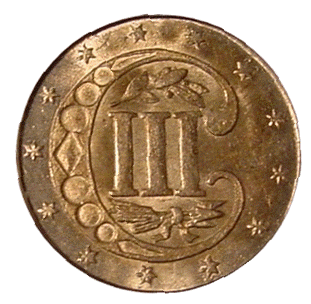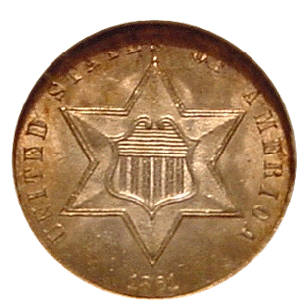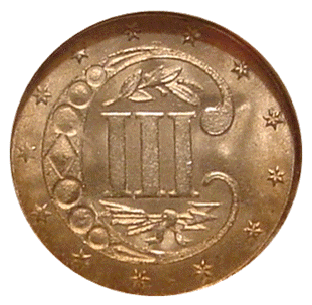Written by:By Bill Jones
All material and images owned by Bill Jones
Recent increases in postage rates remind me of a time in the 19th century when the government decreased the postage rate and issued a new coin to make the purchase of postage stamps easier. In 1851 Congress reduced the postage rate for a letter from five to three cents and authorized a new coin, the silver three-cent piece or “trime,” to facilitate the transition.
Although the mint had been issuing large cents for almost 60 years, the big pennies were never popular and were seldom seen in circulation outside of the big cities. Therefore it was highly unlikely that a customer in rural post office would have had three cents to purchase a stamp, and it was almost equally unlikely that a postal clerk would have had two cents to make change from a Half-dime.
Further complicating situation was the fact that many of the current silver coins were disappearing from circulation. The reason was that the discovery of huge gold deposits in California had upset the ratio between the prices of gold and silver. As a result every United States silver coin contained more precious metal than its face value. This led to widespread hoarding and melting.
The trime was the smallest coin that the United States Government has ever issued. It was also the first U.S. coin that the Government freely admitted contained less precious metal than its face value. Although the trime has larger a diameter than the Type I gold dollar, it weighs less than half as much. In fact the coin is so tiny and so thin that it is almost impossible to lift the piece from a flat surface such as a tabletop. This prompted some people to call these tiny coins “fish scales,” which was a term of derision.


The Type I Trime (1851-3)
The first !rimes appeared in circulation in 1851. The tiny coins were made of a different alloy that consisted of 75% silver and 25% copper.Previously all U.S. silver coins had contained "around" 90% silver and 1 0% copper.
(Note: The earliest U.S. silver coins legally mandated to be 89.24% silver and 10.76% copper. That standard proved to be unworkable and was ultimately changed.)
The small size of the coin required the design to be fairly simple.
The obverse featured a six pointed star with a U.S. shield in the center. This device was surrounded by the legend, "United States of America," with the date at the bottom. The reverse featured a large "C" with the Roman numeral "Ill" in the center. This was surround by 13 stars. Initially the coin was quite popular. and the government issued over 36 million pieces in the first three years.
Today the Type I trime (1851-3) is quite common in well circulated condition. Although most pieces are well struck. many trimes show some weakness down the center of the shield in the middle of the star: and some of the 1851-0 trimes are poorly struck in the date area. The 1851-0 is one of my favorite coins. It was the only three cent piece that was issued by a branch mint, and its mintage of 720,000 pieces was relatively low. Despite those factors the coin has not been a prime collector favorite, and its price is quite reasonable.


The Type II Trime (1854-B)
In 1854 Congress changed the composition of the trime to the standard 90% silver. 10% copper alloy. Perhaps as a reflection of that change, Chief Mint Engraver, James Longacre. with the approval of the mint director. modified the design of the trime. The modifications included a triple border around the edge of the star on the obverse and the addition of an olive branch above and a bundle of arrows below the Roman numeral "Ill" on the reverse. Perhaps because Longacre had tried to put too much detail on an extremely thin coin. the Type II !rimes are almost never fully struck. Usually parts of the border around the star are missing. and virtually all of the coins show weakness in the center of the shield. Since there were many Type I trimes were already in circulation. the mintage of the Type II pieces was relatively small. In addition far fewer pieces were saved. and today the Type II trime is quite scarce and expensive in Mint State condition. Some pieces also have striation lines across their surfaces because those marks were on the planchets (coin blanks) before the coins were struck and not flattened by the dies. This striation problem is also seen to a greater degree on the rare Type II Proof !rimes. These lines, which result from die polishing, not planchet problems, reduce the eye appeal of these coins considerably.


The Type III Trime (1859-73)
In 1859 James Longacre successfully modified the trime design, and the appearance of the coin improved considerably. The Type III trimes had a double border around the outside of the shield and smaller, narrower letters and dates. Those modifications were enough to correct the previous mechanical problems that had plagued the coin.
The Type III trimes were issued in fairly large numbers (almost 1.5 million coins) from 1859 to 1862. By the end of that period the Civil War was in full swing, and the people were hoarding silver coins including the trimes. As a result the mintages for all U.S. silver coins fell to very low levels during the Civil War.
In 1865 the mint introduced the nickel three cent piece. The new coin was larger and easier to handle, which made the trime obsolete. Although the Mint continued to strike a few thousand business strike trimes each year along with several hundred Proof coins, virtually none of the business strike pieces left the government’s vaults. By 1873 the Mint had 74,000 trimes on hand including almost all of the 1863 to 1873 mintage. When Congress ended the mintage of the trime, these coins were melted thus making the few business strike trimes from that period very scarce. Today nearly all of the 1863 to 1873 trimes that are available to collectors are Proof coins. The few remaining Mint State pieces are rarities that sell for higher prices than their Proof counterparts.

